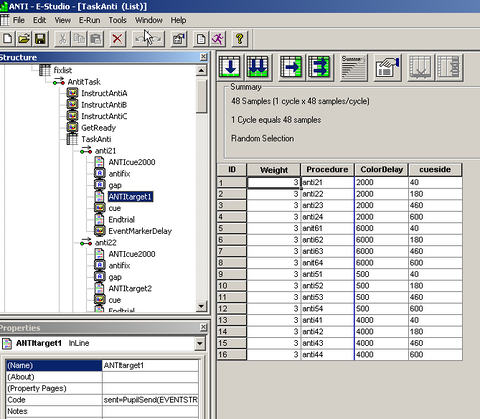Antisaccade Tasks
The LNCD has a collection of tasks varying how a participant should look away from or to a dot.
Scoring by Automatic Eye Scoring, see github readme citation section lab papers methods quotes. See Eye Tracking for camera hardware.
 Fig 1. Anti-saccade task, taken from Luna et al, NeuroImage, 2001.
Fig 1. Anti-saccade task, taken from Luna et al, NeuroImage, 2001.
Versions
The breakdown of antisaccade tasks is below. For all Eye Tracking tasks, see EyeTracking Task Table (includes Memory Guided Saccade (MGS) Task).
| Version | sides | cue | timing | grants |
|---|---|---|---|---|
| Dollar Reward | 6 | rew/nue | .5s cue | EPrime Cog Grant?; Psychopy Habit Study (R37), Synaptic Pruning Adolescence (SPA). NCANDA |
| Anti Antisaccade Task | 4 | red cross | var cue, 200ms blank, var iti | eprime behave PET Study, Brain Mechanisms R01 (7T) |
| AntiState Mix | ||||
| bars | rew/pun w/levels | |||
| Anti @ EEG |
Anti Task by Project
| Dates | Project | Location | version | Tracker | File |
|---|---|---|---|---|---|
| Cog | Loef | DollarReward | ASL | ||
| Cog | NIC | DollarReward (MR) | ASL LRO | ||
| Reward | Loef | Bars | ASL | ||
| Reward | MRRC | Bars (MR) | ASL LRO | ||
| PET | MRRC (mMR) | Frogger | ASL LRO | ||
| 2018-01-24 - 2022-10-27 | 7T | Loef | Anti | ASL | |
| 7T | BST3 7T | mgs_encode | Avotec | ||
| 7T | EEG | Anti | EOG | ||
| Habit | Loef | DollarReward | Avotec,EyeLink | ||
| Habit | EEG | DollarReward | EOG | ||
| SPA | Loef | DollarReward | ASL,EyeLink? | ||
| SPA | EEG | Anti | EOG |
Exclusion Criteria
- Fewer than 25 viable trials (this means they have to have 25 (n) that are not dropped/scored as -1 (can be 0,1,2)) - what we consider the minimum of trials where we believe the ppt actually understood the task
- Less than 50% 'on task' trials (coded as 1,2)
- Statistical outliers by the residuals of the model; ppt whose residuals are ±2 SD from the mean across any measure
-in progress
Behavioral Data
RAW FILES FROM EYE TRACKER ARE EDF OR EYD—– NEED TO BE CONVERTED TO ASC FOR SCRIPT TO WORK
To score, you need to
- Identify data location
- Source dollarreward.R script in order to create score_all_anti function [https://github.com/LabNeuroCogDevel/autoeyescore/tree/master/EyeLink]
- Run all data through function [if Habit;
alldollarreward_data ← score_all_anti(“/Volumes/L/bea_res/Data/Temporary Raw Data/lab_eyetracker/subj_info/sub-1*/ses*/*_DollarReward/sub_*.asc*”)]
Data should have a row for every trial (repeating lunaid) and saccade information per column (ex: dot position, trial type, latency, number of saccades, and computed event outcome)
- Clean data by extracting lunaid, visit date, neutral vs reward trials, mutate variables you want like mean latency, correct response rate (accuracy), percent of error corrected trials (error rate) see https://github.com/LabNeuroCogDevel/Antisaccade-impulsive-control/blob/main/EyeLink/Dollarreward_cleaning.Rmd
- Turn to wide format so each row represents a single participant
Coding outcome from Automatic Eye Scoring:
-1, dropped event or bad eye tracking0, incorrect- the participant looked directly at the stimulus1, correct- the participant looked in the opposite direction of the stimulus2, error corrected- the participant first looked at the stimulus then looked in the opposite direction
percent of error corrected trials is computed as trials scored 2/0+1+2, can be computed as 2/1+2.
EOG Data
Raw files from EEG are .bdf and can be read immediately into MATLAB script
- Open MATLAB scoring script [
/Volumes/Hera/Projects/7TBrainMech/scripts/eeg/eog_cal] - Identify data location [if Habit:
/Volumes/Hera/Raw/EEG/Habit] - Grab
subject*_anti.bdfandsubject*_eyecal.bdf - Information on stimulus channel output, see dollarreward.py
- Run script? Should export long-format csv with all variables of interest that can be pulled into R
Processed csv read into R
STEPS REPEATED AS ABOVE FOR BEHAVIORAL DATA
- Data should have a row for every trial (repeating lunaid) and saccade information per column (ex: dot position, trial type, latency, number of saccades, and computed event outcome)
- Clean data by extracting lunaid, visit date, neutral vs reward trials, mutate variables you want like mean latency of correct trials, correct response rate (percent of correct trials; accuracy), percent of error corrected trials (error rate), latency variability for correct trials
- Turn to wide format so each row represents a single participant [see code
/Volumes/Hera/Victoria/Antisaccade-impulsive-control/EOG_Antisaccade_cleaning.Rmd]
**percent of error corrected trials is computed as trials scored 2/1+2.
- Analyze variables of interest [
/Volumes/Hera/Victoria/Antisaccade-impulsive-control/Analysis_EOG_as_data.Rmd]
EEG Data (EPrime)
For 7T EEG
Trigger
[micromed_time, mark]=make_photodiodevector(EEG);
iti = mode(mark);
mark = mark - iti + 254;
% 101-105: anti cue
% 151-155: target (dot on, look away)
% 254 = back to fixation
simple = nan(size(mark));
simple(mark == 254)= 1; % (New ITI)
simple(mark>=100 & mark<110)= 2; % (new Anti cue - red fixation cross, prepatory)
simple(mark>=150 & mark<= 155)= 3; % (new dot on, look away)
References:
- Hallett, P. E. (1978). Primary and secondary saccades to goals defined by instructions. Vision research, 18(10), 1279-1296.
- Luna, B., Thulborn, K. R., Munoz, D. P., Merriam, E. P., Garver, K. E., Minshew, N. J., Keshavan, M. S., Genovese, C. R., Eddy, W. F., & Sweeney, J. A. (2001). Maturation of Widely Distributed Brain Function Subserves Cognitive Development. NeuroImage, 13(5), 786–793.


